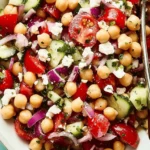Dublin Coddle is a traditional Irish stew that combines sausages, bacon, potatoes, and onions, all slowly simmered to create a hearty and comforting dish. Historically, it was prepared in the evening and left to “coddle” gently, making it a perfect meal to enjoy after a visit to the pub. This flavorful stew is especially popular during colder months and is a staple for St. Patrick’s Day celebrations.
FULL RECIPE:
Ingredients
- 8 strips thick-cut bacon, cut into 1-inch pieces
- 2 tablespoons butter
- 2 yellow onions, chopped
- 4 cloves garlic, minced
- 1 cup chopped green onions, plus more for garnish
- 1 cup stout beer
- 1 tablespoon fresh thyme leaves
- ¼ cup chopped Italian parsley
- Freshly ground black pepper, to taste
- 2 teaspoons kosher salt, or to taste
- Pinch of cayenne pepper
- 2 pounds Yukon Gold potatoes, peeled and cut into large chunks
- 4 cups chicken broth
- 1 pound Irish pork sausage links
Directions
-
Cook the Bacon: In a large Dutch oven over medium heat, cook the bacon pieces until browned but not crispy. Remove the bacon and set aside, leaving the rendered fat in the pot.
-
Sauté Onions and Garlic: Add butter to the pot with the bacon fat. Stir in chopped yellow onions and a pinch of salt; cook until onions are soft and translucent. Add minced garlic and chopped green onions; cook for an additional 2 minutes.
-
Deglaze with Beer: Pour in the stout beer, raise heat to high, and cook, stirring occasionally, until the beer has reduced by about 75%. Season with fresh thyme leaves, chopped Italian parsley, freshly ground black pepper, kosher salt, and a pinch of cayenne pepper.
-
Add Potatoes and Broth: Once the beer has reduced, add the peeled and chunked potatoes to the pot. Pour in the chicken broth and bring to a simmer.
-
Prepare Sausages: Preheat the oven to 300°F (150°C). Prick the sausage links on both sides and place them on top of the simmering ingredients in the pot.
-
Bake the Stew: Cover the Dutch oven with a lid and transfer it to the preheated oven. Bake for 2½ hours. After this time, remove the lid and continue baking for an additional hour to allow the sausages to brown slightly.
-
Serve: Garnish with additional chopped green onions and serve hot. This stew pairs wonderfully with Irish soda bread.
Nutrients Per serving:
- Calories: 284
- Total Fat: 16g
- Saturated Fat: 6g
- Cholesterol: 57mg
- Sodium: 852mg
- Total Carbohydrate: 18g
- Dietary Fiber: 3g
- Total Sugars: 7g
- Protein: 16g
- Vitamin C: 7mg
- Calcium: 137mg
- Iron: 1mg
- Potassium: 559mg
The History and Origins of Dublin Coddle
Dublin Coddle is a beloved Irish dish that carries a rich history and deep cultural roots. Traditionally, it has been associated with the working-class communities of Dublin, dating back to the 18th century. The name “coddle” comes from the slow, gentle cooking method used to prepare the dish, allowing flavors to develop over time. It is said that this hearty stew became popular as a way for households to use up leftover sausages and bacon, ensuring that no food went to waste. Historically, Dublin Coddle was often made in the evenings and left to simmer on the stove, providing a warm and filling meal for family members returning home late from work or the pub. The dish has also been linked to Ireland’s economic struggles, as it was a simple, budget-friendly meal that provided nourishment with minimal ingredients. Over time, it has evolved from a necessity to a cherished comfort food that is enjoyed not only in Ireland but also by Irish communities around the world.
What Makes Dublin Coddle Special?
Dublin Coddle stands out due to its simplicity and the depth of flavor that comes from slow cooking. Unlike many stews that require a variety of vegetables and spices, this dish relies on just a handful of key ingredients—sausages, bacon, onions, potatoes, and broth. The magic of the dish lies in how these ingredients interact over long, slow heat, creating a rich, flavorful broth that is both savory and slightly smoky. Another unique aspect of Dublin Coddle is its flexibility.
Cultural Significance and Traditional Consumption
Dublin Coddle is deeply ingrained in Irish culture and is often associated with St. Patrick’s Day celebrations. Although not as globally recognized as corned beef and cabbage, this dish is a staple for many Irish families during the holiday. It embodies the heartiness of traditional Irish cuisine and offers a taste of home for many Irish people living abroad. Beyond St. Patrick’s Day, Dublin Coddle is often prepared during the colder months, as its warming and nourishing properties make it an ideal winter dish. In Irish households, it is frequently served as a casual weekend meal, especially when there are leftovers that need to be used up.
Variations and Modern Twists
While the classic Dublin Coddle recipe remains largely unchanged, many modern chefs and home cooks have found ways to put their own spin on it. Some popular variations include:
- Vegetarian Dublin Coddle: Instead of sausages and bacon, some people use plant-based alternatives or add extra vegetables such as mushrooms, parsnips, and cabbage to create a meat-free version that retains the dish’s hearty appeal.
- Spicy Dublin Coddle: Adding a touch of heat with chili flakes, smoked paprika, or spicy sausages can enhance the dish’s flavor profile.
- Guinness-Infused Coddle: Incorporating a bottle of Guinness or another Irish stout into the broth deepens the stew’s richness and adds a slight bitterness that balances the sweetness of the onions and potatoes.
- Slow Cooker Dublin Coddle: Many busy home cooks opt to make this dish in a slow cooker, allowing the flavors to develop even further while making meal preparation more convenient.
- Oven-Baked Dublin Coddle: While traditionally simmered on the stovetop, some variations involve baking the coddle in a covered dish for a more roasted, concentrated flavor.
Tips for Making the Best Dublin Coddle
To ensure a flavorful and authentic Dublin Coddle, consider the following tips:
- Choose High-Quality Sausages: The sausages are the star of the dish, so using high-quality Irish pork sausages will greatly enhance the flavor. If you cannot find traditional Irish sausages, opt for a mild, high-quality pork sausage with minimal seasoning.
- Don’t Skip the Bacon: Bacon adds a smoky, salty depth to the broth, making it a key ingredient in the dish. Thick-cut bacon or pancetta works best.
- Layer the Ingredients Properly: To achieve the best texture, layer the potatoes on the bottom of the pot so they absorb the broth, while the sausages remain on top to brown slightly.
- Cook Low and Slow: The longer Dublin Coddle simmers, the more flavorful it becomes. A slow cooking process allows the ingredients to meld together, creating a rich, comforting dish.
- Allow for a Resting Period: After cooking, let the stew sit for 10–15 minutes before serving. This resting period allows the flavors to settle and intensify.
- Use Homemade Broth: If possible, use homemade chicken or beef broth instead of store-bought versions for a fresher and more authentic taste.
Serving Suggestions
Dublin Coddle is best served piping hot, with some traditional Irish accompaniments. Consider pairing it with:
- Irish Soda Bread: This quick and easy bread is perfect for soaking up the flavorful broth.
- Boiled Cabbage or Colcannon: A side of cabbage or mashed potatoes mixed with kale (colcannon) complements the dish beautifully.
- Pickles or Mustard: Some enjoy a tangy contrast by serving the stew with a side of pickles or mustard.
- A Pint of Guinness: If you enjoy beer, a classic Irish stout like Guinness pairs exceptionally well with the deep, savory notes of the coddle.
Health Benefits of Dublin Coddle
While Dublin Coddle is considered a comfort food, it does have some nutritional benefits:
- Good Source of Protein: The sausages and bacon provide a protein boost, which is essential for muscle health and overall body function.
- Rich in Potassium: The potatoes used in the stew are a great source of potassium, which supports heart health and helps regulate blood pressure.
- Contains Essential Nutrients: Onions and garlic, common in Dublin Coddle, offer antioxidants and immune-boosting properties.
- Customizable for a Healthier Version: If you want a lighter version, opt for leaner sausages, reduce the bacon content, and add more vegetables to increase fiber and vitamins.
Conclusion
Dublin Coddle is more than just a meal; it is a dish steeped in history, culture, and tradition. From its humble origins as a working-class staple to its place in modern kitchens, this Irish stew continues to warm hearts and fill stomachs. The beauty of Dublin Coddle lies in its simplicity, rich flavors, and ability to bring people together. Whether you are celebrating St. Patrick’s Day, seeking a comforting winter meal, or simply looking to explore traditional Irish cuisine, this dish is a perfect choice.






